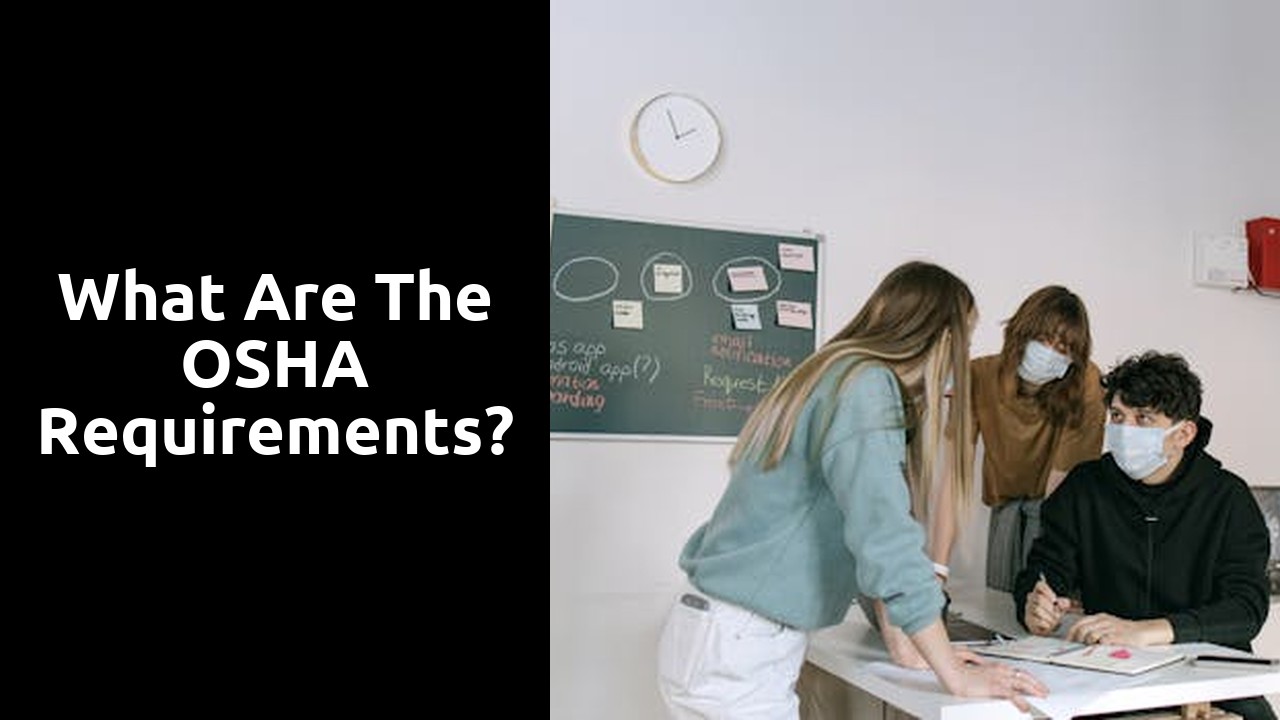What are the OSHA requirements?

Conducting OSHA Inspections
Conducting OSHA inspections is a critical aspect of ensuring workplace safety and compliance with regulations. OSHA inspectors typically arrive unannounced to assess the work environment, identify potential hazards, and ensure that employers are following safety protocols. During these inspections, inspectors will review records, interview employees, and examine the workplace to identify any violations of OSHA standards. Advising on workplace safety is a key responsibility of OSHA inspectors, as they provide guidance on how to address any identified hazards and prevent future incidents. It is essential for employers to cooperate fully with the inspectors and address any violations promptly to maintain a safe work environment.
Common OSHA Violations to Look Out For
Common OSHA violations can pose serious risks to employees and result in hefty fines for businesses. Failure to maintain proper machine guarding is a frequent violation that can lead to severe injuries or fatalities. Employers must ensure that all machinery is securely guarded to prevent accidents. Another common violation is inadequate training on hazardous materials handling. Employers are required to provide comprehensive training to employees who handle hazardous materials to minimize the risk of accidents or exposure to harmful substances. Advising on workplace safety is crucial to prevent these violations and protect the well-being of employees.
Reporting OSHA Incidents
Reporting OSHA incidents is a critical aspect of ensuring workplace safety and compliance with regulations. In the event of an incident that falls under OSHA's reporting requirements, employers must promptly inform OSHA. This includes any work-related fatalities, hospitalizations, amputations, or losses of an eye. By promptly reporting such incidents, employers not only fulfill their legal obligations but also contribute to a safer work environment for all employees. Advising on workplace safety should be a priority, and reporting incidents serves as a crucial step in addressing potential hazards and preventing future accidents. Proper reporting also allows OSHA to investigate the incident thoroughly, identify root causes, and recommend corrective actions to prevent similar occurrences in the future.
OSHA Recordkeeping Requirements
Ensuring proper OSHA recordkeeping is essential for all businesses to maintain a safe work environment and stay compliant with regulations. Employers must keep accurate records of all work-related injuries and illnesses, including details on the incident, the injured employee, and any medical treatment provided. These records are not only crucial for employee safety but also for OSHA inspections to verify that the workplace is adhering to safety standards. Advising on workplace safety, OSHA requires that employers maintain these records for a minimum of five years to ensure transparency and accountability in the case of any inquiries or investigations.
Ensuring OSHA Compliance
Ensuring OSHA compliance is a critical aspect of maintaining a safe work environment. Employers must prioritize adherence to OSHA regulations to protect their employees and mitigate the risk of violations. By proactively implementing safety protocols, conducting regular training sessions, and staying informed about OSHA standards, organizations can create a culture of safety within the workplace. Advising on workplace safety is not just a legal obligation; it is a moral responsibility to uphold the wellbeing of all individuals involved in the work environment.
Moreover, conducting internal audits, inspecting the workplace for potential hazards, and addressing any identified issues promptly are essential steps in ensuring OSHA compliance. By fostering open communication channels regarding safety concerns and encouraging employee participation in safety initiatives, companies can actively engage their workforce in promoting a safe and healthy workplace. Upholding OSHA standards is an ongoing commitment that requires dedication and vigilance from both employers and employees to create a workplace that prioritizes safety above all else.
Steps to Take in Case of an OSHA Inspection
In the event of an unexpected OSHA inspection at your workplace, it is crucial to remain calm and cooperative. The immediate step to take is to designate a specific individual to escort the OSHA compliance officer around the premises. This individual should be knowledgeable about the facility and capable of answering questions accurately. Advising on workplace safety measures and providing necessary documentation promptly showcases your commitment to maintaining a safe work environment.
During the inspection process, refrain from interfering with the OSHA compliance officer's duties. It is important to allow them to carry out their assessment freely and address any concerns they may have. Take notes on the inspector's findings and ask for clarification if needed to ensure a clear understanding of any potential violations. After the inspection, develop a comprehensive plan to address any issues identified and make necessary improvements to uphold OSHA compliance standards.
FAQS
What does OSHA stand for?
OSHA stands for Occupational Safety and Health Administration, which is a government agency that sets and enforces workplace safety and health regulations.
What are the common OSHA violations that employers should look out for?
Common OSHA violations include failure to provide personal protective equipment, inadequate training, lack of machine guarding, improper hazard communication, and unsafe working conditions.
How should employers report OSHA incidents?
Employers are required to report serious injuries, illnesses, and fatalities to OSHA within a specific timeframe. They can do so by calling the OSHA hotline or reporting online through the OSHA website.
What are the recordkeeping requirements set by OSHA?
OSHA requires employers to maintain accurate records of work-related injuries and illnesses. This includes keeping injury and illness logs, incident reports, and medical records for a specific period of time.
How can employers ensure OSHA compliance in their workplace?
Employers can ensure OSHA compliance by conducting regular safety inspections, providing adequate training to employees, implementing safety protocols, and addressing any hazards or violations promptly.
What steps should employers take in case of an OSHA inspection?
In case of an OSHA inspection, employers should cooperate with the compliance officer, provide necessary documentation, address any identified violations promptly, and follow up with corrective actions to prevent future incidents.
Related Links
Advising on workplace safetyIs OSHA required in New York?
Is OSHA 40 mandatory in NYC?